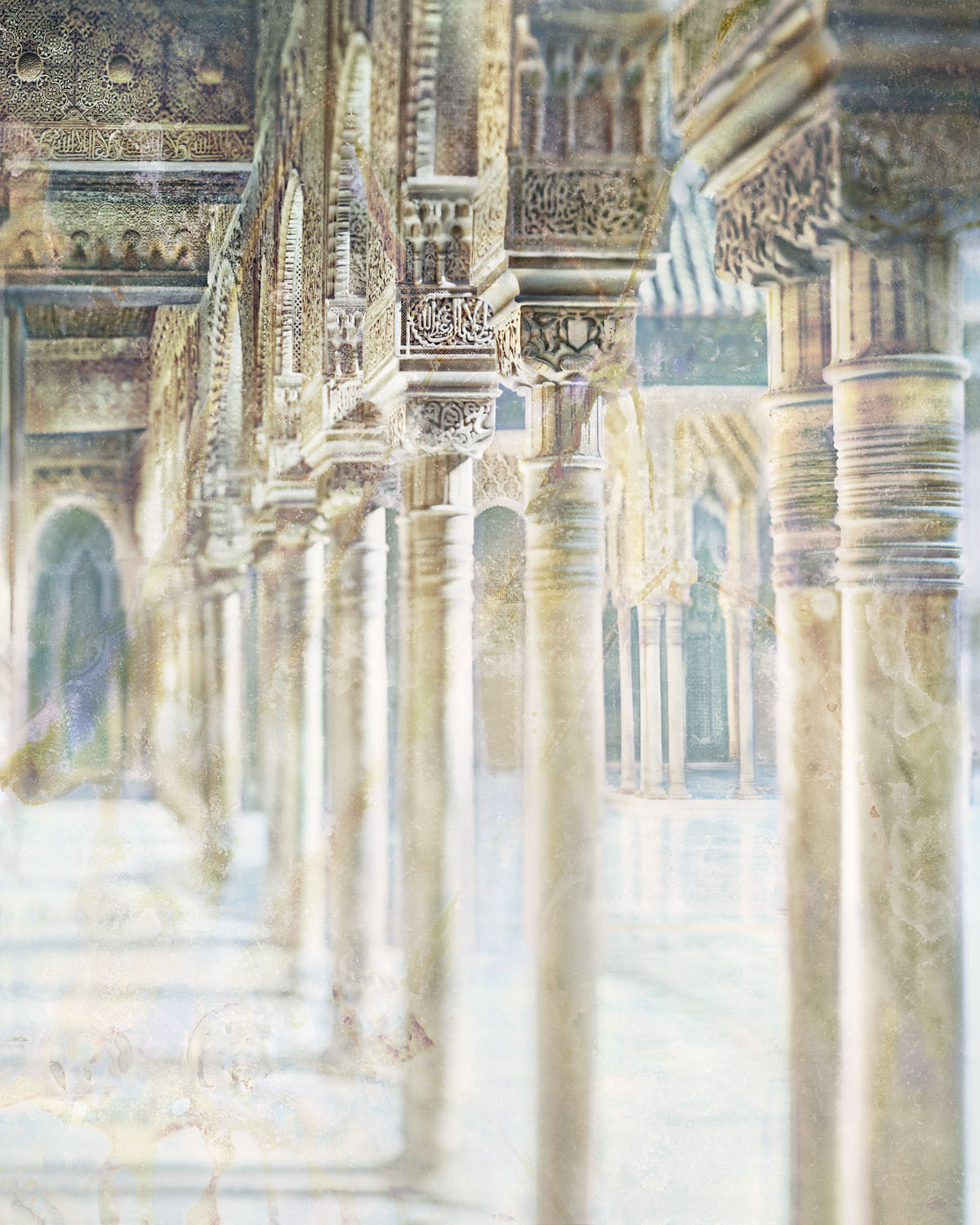 BACK
BACK
The Partal
A great pond located in the center, presided by the portico after which is found the tower of the Ladies.
 Make your selection to discover more places
Make your selection to discover more places
A small pergola leads to a wide esplanade corresponding to the lower terrace of the Partal. To the left is the architectural structure for which the location is named: the Partal Palace portico.
As is customary in these buildings, it is situated, like the Palace of Comares, on the premises wall. The portico, with its five arches, overlooks a large pool in the centre of the garden. Behind the portico is the main room, located inside the tower known as Las Damas.
The wall decoration typically consists of a tile socle and wide stretches of plasterwork that originally were polychromatic friezes with wooden frameworks. Its decorative style suggests that it was built during the reign of sultan Muhammad III (1302-1309), making it the oldest—if only partially standing—palace in the Alhambra.
Adjacent to the Tower of the Ladies and above the portico, is a lovely small balcony built in Nasrid style, just like the balconies of other palaces, such as the Comares and the Generalife, often referred to in this day and age as observatories for the superb views they provide.
One of the reasons why the Palace of the Partal stands out from its neighbouring Comares and the Lions, which have maintained their overall structure since the days of the Nasrid, is that the Partal was only included in the Alhambra a little more than a century ago.
On 12 March 1891, its owner, Arthur Von Gwinner, handed ownership over to the State. At that time the building was little more than a simple house with a few plants. Its interior walls were covered over so that much of the structure and its original decoration were hidden from view.
Another detail of note is the fact that the wooden ceiling inside the Tower of the Ladies was dismantled by its last owner, turning up early last century in Berlin. It is currently one of the most prominent objects to be found in the Museum für Islamische Kunst del Staatliche Museen Preussischer Kulturbesitz..
Finally, the two large marble lions that stood in the front of the gallery, and which dated back to the 14th Century, were originally from Maristán, in Albaycin.
In 1995 the lions were moved to the Museum of the Alhambra in order to be restored and preserved. In the mid-nineteenth century, they had been in the Partal, where their preservation, chronology, function, and context were ignored.
The Partal Gardens
This lovely section of the Monumental Complex of the Alhambra is the result of a logically pursued process, carried out by a well-managed system of landscaping and architectural planning, which was put into effect in the 1930s and has been a determinant in the increase in tourism, establishing current perspectives of interpretation.
Since the mid-nineteen hundreds various acquisitions and expropriations of small properties from private owners in the area have facilitated a series of archaeological explorations.
Walls, pavements and other architectural elements were recovered, particularly in the first three decades of the twentieth century. In addition, landscaping was put into effect, so that archaeological recoveries could be properly integrated into the surrounding flora and countryside, thus providing a noteworthy example that has bolstered the notoriety of the Alhambra around the world.
The original mechanism pertains to a terracing process, in which terrain levels, ascending from the wall to the fortress, and elevated above the left bank of the Darro river basin, in the direction of the upper Alhambra, were colonized and urbanized, on what was probably the site of the original Nasrid palace settlement.
THE PARTAL CHAPEL
The square shaped chapel stands adjacent to the Partal. Because of its decoration, the chapel is believed to have been constructed during the reign of Yusuf I. The mihrab is correctly situated in the Alhambra tradition. Structurally part of the main wall, the chapel blends in with the countryside, thus enhancing its suitability for the sultan’s prayers and meditations on nature and creation.
THE PARTAL DWELLINGS
A group of houses built on the wall in the 14th Century, the Partal Dwellings are part of the palace portico.
The four two storey detached Partal Dwellings—the González Pareja house, the Villoslada house, the House of the Balconies and the House of the Paintings—have no courtyards. They are known for their interior plasterwork, armour, and particularly for their courtly mural paintings, which some authors claim are the only examples of Nasrid painting in the entire Historical-Artistic Monuments Complex, the paintings of the Hall of the Kings and the Court of the Lions having been done by Christians painters.

La Alhambra, a look from Fernando Manso
MORE INFORMATION
WASHINGTON IRVING AND THE ALHAMBRA
MORE INFORMATION
THE GATE OF BIBARRAMBLA. Historical report of the monument and its rediscovery
MORE INFORMATIONTHE EMPEROR´S CHAMBERS
MORE INFORMATION
The Council of Alhambra and Generalife will refund automatically the full amount of the bookings
MORE INFORMATION





 Contact
Contact


















